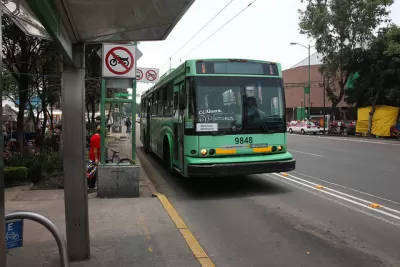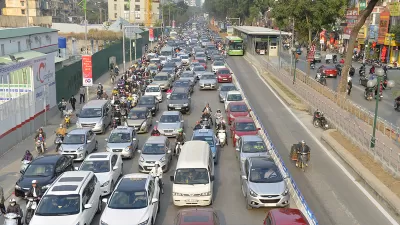The curious and, at times, dangerous design of bus lanes that move against the flow of traffic in Mexico city will be expensive and time-consuming to take out, so the city looks for ways to work with what it has.

Mexico City's buses sometimes drive in their own lanes in the opposite direction of traffic on one-way streets. The design was created in the '70s when the city was looking for ways to increase the throughput of private vehicles. The one-ways allow for wider lanes and higher speeds, and accommodate bus travelers who would have to walk to more distant one-way streets to catch a bus.
So the city built bus-only lanes for buses to go in the opposite direction of traffic. A problem with this design is that drivers sometimes do not recognize the uncommon design and pull into the lane of the oncoming bus. "World Resources Institute, a research organization that found a 146 percent increase in pedestrian crashes and a 35 percent increase in vehicle collisions in counterflow lanes," Natalie Schachar reports in CityLab. Unfortunately, updating these streets would cost $6 million per kilometer. "For now, the next best solution appears to be optimizing bus corridors by installing better signaling, mid-block crossings, and physical barriers to prevent vehicles and pedestrians from straying into the wrong lane," Natalie Schachar writes.
FULL STORY: Why Mexico City Has Counterflow Bus Lanes

Alabama: Trump Terminates Settlements for Black Communities Harmed By Raw Sewage
Trump deemed the landmark civil rights agreement “illegal DEI and environmental justice policy.”

Planetizen Federal Action Tracker
A weekly monitor of how Trump’s orders and actions are impacting planners and planning in America.

The 120 Year Old Tiny Home Villages That Sheltered San Francisco’s Earthquake Refugees
More than a century ago, San Francisco mobilized to house thousands of residents displaced by the 1906 earthquake. Could their strategy offer a model for the present?

Indy Neighborhood Group Builds Temporary Multi-Use Path
Community members, aided in part by funding from the city, repurposed a vehicle lane to create a protected bike and pedestrian path for the summer season.

Congestion Pricing Drops Holland Tunnel Delays by 65 Percent
New York City’s contentious tolling program has yielded improved traffic and roughly $100 million in revenue for the MTA.

In Both Crashes and Crime, Public Transportation is Far Safer than Driving
Contrary to popular assumptions, public transportation has far lower crash and crime rates than automobile travel. For safer communities, improve and encourage transit travel.
Urban Design for Planners 1: Software Tools
This six-course series explores essential urban design concepts using open source software and equips planners with the tools they need to participate fully in the urban design process.
Planning for Universal Design
Learn the tools for implementing Universal Design in planning regulations.
Clanton & Associates, Inc.
Jessamine County Fiscal Court
Institute for Housing and Urban Development Studies (IHS)
City of Grandview
Harvard GSD Executive Education
Toledo-Lucas County Plan Commissions
Salt Lake City
NYU Wagner Graduate School of Public Service





























